#aurignacian
Explore tagged Tumblr posts
Text
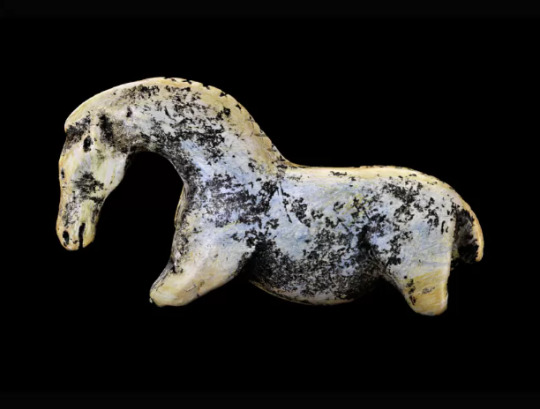
Horse figurine carved from mammoth ivory, discovered in a cave in Germany, aprox. 32,000 - 35,000 years old
1K notes
·
View notes
Text


Couple of quick sketchbook doodles today. First is an attacking Aurignacian woman from late Pleistocene Europe, and the second is a preening Deinonychus.
#prehistoric#aurignacian#paleolithic#pleistocene#european#black woman#woman of color#dark skin#bipoc#warrior woman#deinonychus#raptor#dromaeosaurid#dinosaur#mesozoic#cretaceous#paleoart#drawing#traditional art#art#doodles
21 notes
·
View notes
Text

Flight of the geese.
More ice age oc art.
#my art#prehistoric art#prehistory#prehistory art#Paleoart#prehistoric oc#paleo oc#paleolithic#paleolithic oc#paleoblr#aurignacian#gravettian
114 notes
·
View notes
Text
A-aea (Spear and Fang): Bush or Bald?

A-aea is a "cro-magnon," a now discarded term for the first anatomically modern humans in Europe. Today, we call them Aurignacians. Aurignacian blades were crude stone implements that no lady should ever put near her lady cave.
Verdict: bush
#spear and fang#robert e. howard#cro-magnon#aurignacian#prehistoric#primitive pussy#bush#bushes of colour
5 notes
·
View notes
Text

Libor Balák - A Shaman of the Aurignacian Culture
#prehistory#archaeology#paleolithic#stone age#shaman#hunter gatherer#shamanism#ice age#Libor Balák#libor balak#aurignacian#art#upper paleolithic#historical reconstruction#or rather prehistorical#my upl
4 notes
·
View notes
Text
Ancient Cave Art | Chauvet, France
The cave of Chauvet in the Ardéche Valley of France contains the earliest known art made by humans—depictions of bears, panthers, horses, and more, made 30,000 years ago. Examining this art closely gives us much information about the humans who created it—what their lives, beliefs, and environment must have been like. Because these cave paintings represent some of the earliest human artistic…
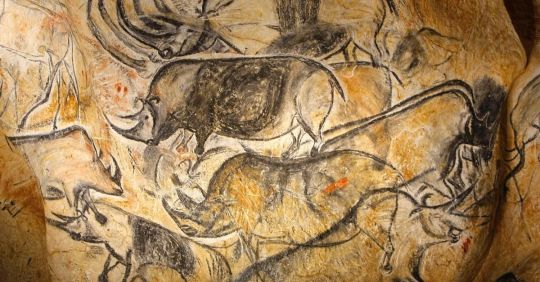
View On WordPress
#ancient#ancient world#art history#Aurignacian#cave#cave art#Chauvet#course#french#history#horses#lions#masterpieces#museum#religion#travel
3 notes
·
View notes
Text

A 34,000 year old Aurignacian lunar calendar carved on a bone-tablet, found in Dordogne in France.
Louvre Museum
NOTE:
The Aurignacian is an archaeological industry of the Upper Paleolithic associated with Early European Modern Humans (EEMH) lasting from 43,000 to 26,000 years ago.
3 notes
·
View notes
Text
Archeologists think they have found the use of a small bone fragment punctured by 10 equidistant small holes dated to nearly 40 000 years ago. Through experimental archeology, a method that uses the known tools and materials of the time to recreate the object, they reverse engineered its making.
With the use of burin and a heavier hammer-like object, they were able to reproduce very similar results. Placing a piece of heavy leather upon the bone and using the tools the pierce it, they were able to recreate the same rounded out marks. Not only does the technique work, it provides an explanation as well. The bone was used as backing in the process of puncturing leather in preparation for sewing it.
TL;DR a team of archeologists figured out the purpose of a 40 000 years old object because the technique and tools that made it are still used today in leather working.

0 notes
Text
Palaeolithic horses painted in the Chauvet Cave at Ardèche in the south of France.
do you ever see paleolithic art and go “oh fuck that’s good” like they hadn’t developed agriculture or the wheel but god damn could they paint horses real good
139K notes
·
View notes
Text
youtube
0 notes
Text

Prepare to be amazed by this astounding relic of humanity's past: a 35,000-year-old mammoth sculpture unearthed from the depths of Vogelherd Cave in Germany, discovered way back in 1931.
This isn't just any old trinket; it's one of the earliest ivory carvings known to mankind.
At a minuscule 3.7 cm (1.5 inches) long and weighing in at a featherlight 7.5 grams (0.26 ounces), this woolly mammoth figurine packs a punch with its intricate details, boasting an elegantly arched trunk and a striking crosshatch pattern on its tiny feet.
Radiocarbon dating proudly associates it with the Aurignacian culture—yes, that’s the era when modern humans first strolled into Europe.
So, what does this delicate masterpiece scream about the artistic flair and cultural depth of our early ancestors?
It's time to dig deep and confront what this craftsmanship reveals about the minds of those who came before us.
32 notes
·
View notes
Text
youtube
Life in Paleolithic Europe 35,000 Years Ago
from Stefan Milo
10 notes
·
View notes
Text

Zlatý kůň Woman In Color
This is my second reconstruction of the Zlatý kůň woman who lived in the area of the Czech Republic around 43,000 years ago. She would represent some of the earliest Upper Paleolithic human settlers to colonize Eurasia from Africa, although analysis of her genome suggests she was ancestral neither to European nor Asian people today and descended from a population predating the West/East Eurasian split. Contrary to some other artistic reconstructions of this specimen, it is likely that, as relatively recent arrivals in Europe, she and her people had retained dark skin from their African ancestors.
#zlaty kun#aurignacian#prehistoric#paleolithic#european#black woman#woman of color#dark skin#bipoc#paleoart#anthropology#paleoanthropology#digital art#art
14 notes
·
View notes
Text
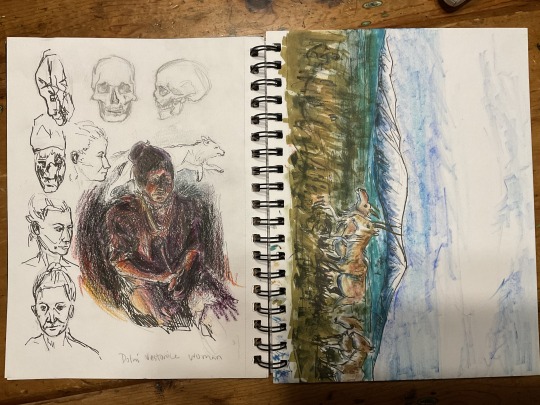
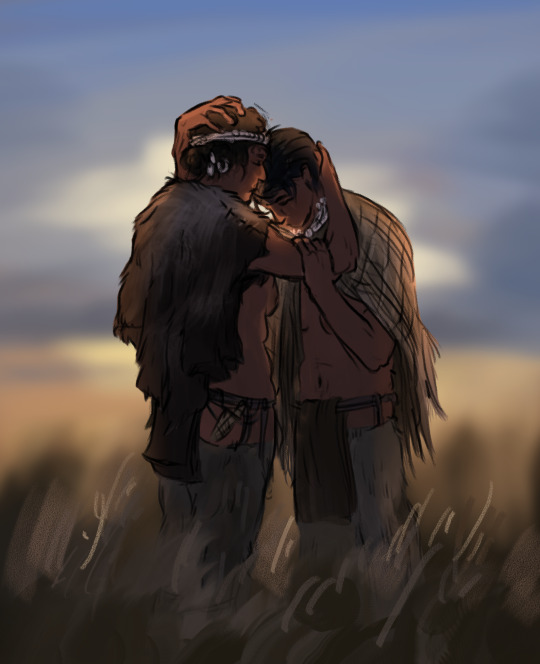

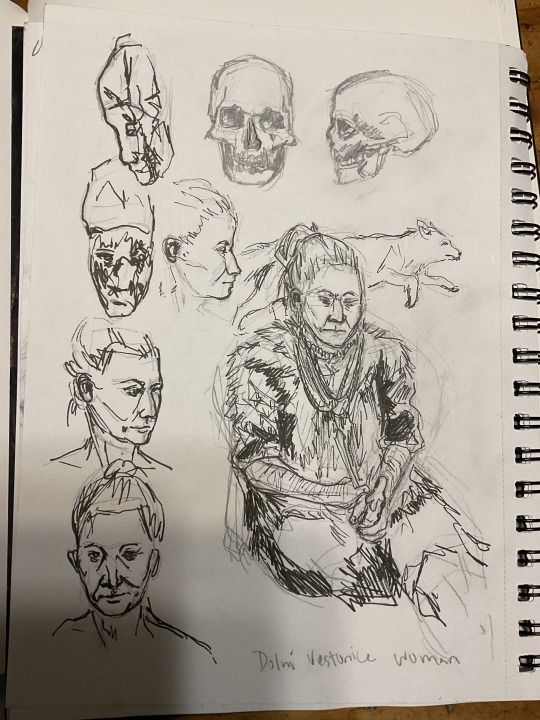
Prehistory-posting
#PREHISTORY#my art#art#artwork#digital art#traditional art#saiga antelope#saiga#paleolithic oc#paleoblr#paleoart#landscape#Gravettian#aurignacian#dolni vestonice#Dolní vestonice
44 notes
·
View notes
Text
Splatoon: The Vestigial Species - Design Ideas (Europe)
If you have not viewed the main post first, please do so. Otherwise, here is a list of archaeological cultures which you are free to choose from to use as an inspiration when designing your human society!
Paleolithic/Mesolithic
Bohunician Culture
Aurignacian Culture
Gravettian Culture
Epigravettian Culture
Solutrean Culture
Magdalenian Culture
Azilian Culture
Maglemosian Culture
Kongemose Culture
Ertebølle Culture
Dnieper-Donets Culture
Pitted Ware Culture
Neolithic
Sesklo Culture
Neolithic Greece
Starčevo–Körös–Criș Culture
Vinča Culture
Karanovo Culture
Gumelniţa Culture
Linear Pottery Culture
Stroke-Ornamented Ware Culture
Rössen Culture
Lengyel Culture
Cardium Pottery Culture
Cucuteni-Trypillia Culture
Michelsberg Culture
Funnelbeaker Culture
Tisza Culture
Globular Amphora Culture
Ozieri Culture
Baden Culture
Bronze Age
-Pastoral
Samara Culture
Khvalynsk Culture
Repin Culture
Yamnaya Culture
Catacomb Culture
Vučedol Culture
Poltavka Culture
Fatyanovo Culture
Abashevo Culture
Sintashta Culture
Srubnaya Culture
-Sedentary
Corded Ware Culture
Bell Beaker Culture
Únětice Culture
Tumulus Culture
Nordic Bronze Age
Terramare Culture
Apennine Culture
Wessex Culture
Atlantic Bronze Age
Hallstatt Culture
Urnfield Culture
Helladic Culture
Cycladic Culture
-Civilizations
Minoan Civilization
Mycenaean Civilization
#splatoon#splatoon 2#splatoon 3#splatoon 4#splatoon headcanon#splatoon fandom#splatoon art#splatoon fanart#fan concept#art contest#collaborative projects#art collab
5 notes
·
View notes
Text

Kebaran Culture: the Palaeolithic's regionally-dominant Levantine Aurignacian made a transition into the Kebaran or Kebarian culture, the very start of the path towards farming.
#history#historyfiles#neolithic#farming#farming revolution#kebaran#ancient cultures#ancient history#ancient world
7 notes
·
View notes